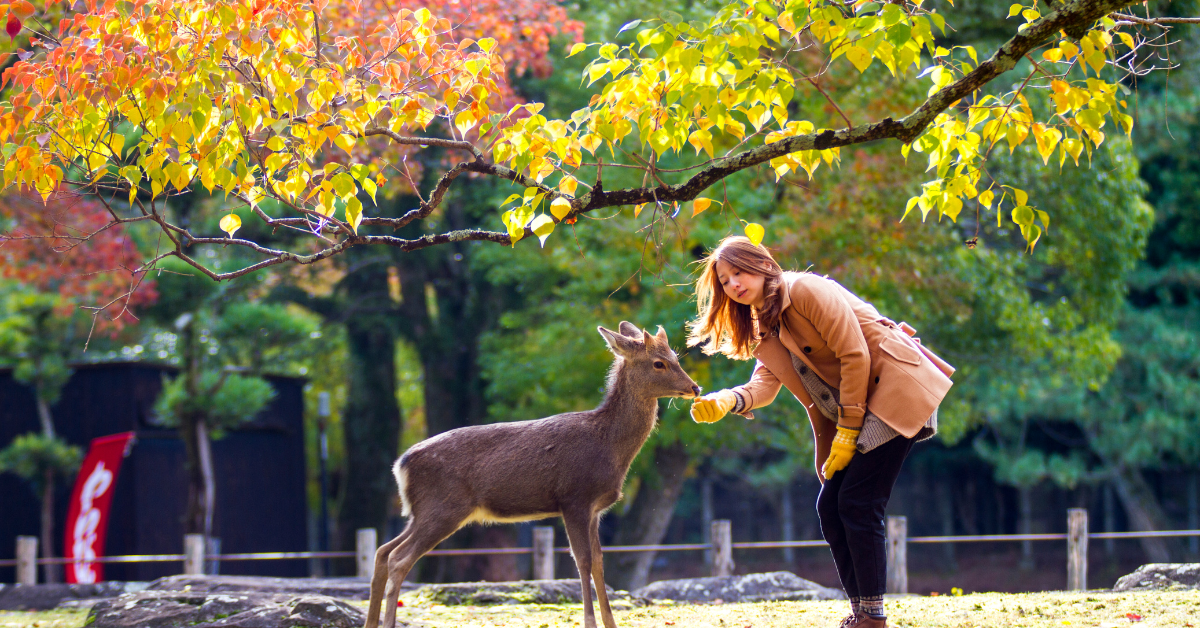Nara Park is not only famous for its freely roaming deer but also holds deep cultural and spiritual meaning for Japanese people. While foreign visitors often focus on the novelty of feeding deer, Japanese see the park as a place where history, nature, and faith harmoniously coexist. Understanding this perspective allows visitors to experience Nara Park on a much deeper level.
The Role of Nara Park for Japanese People
Nara Park is not just an ordinary public park. It carries deep cultural significance at the heart of Japanese tradition. Nara, as Japan’s ancient capital, is home to World Heritage sites such as Tōdai-ji, Kōfuku-ji, and Kasuga Taisha. Surrounding these landmarks, Nara Park symbolizes “a space where history and nature coexist.” For many Japanese, its value is spiritual rather than purely touristic.
Different Views of Nara Park
| Perspective | Japanese View | Foreign View |
|---|---|---|
| Value of the park | A symbol where history, culture, and nature harmonize | A unique sightseeing attraction |
| Purpose of visit | Spiritual peace, education, cultural understanding | Photos, interaction with deer |
| Evaluation | Cultural heritage and tradition | Entertainment and novelty |
Coexistence with Deer as Part of Japanese Culture
The greatest attraction of Nara Park is the close relationship between people and freely roaming deer. Foreign visitors are often amazed to see so many deer walking freely through the city and park. For Japanese, however, deer are regarded as “messengers of the gods” of Kasuga Taisha Shrine and have been protected for centuries. The people of Nara developed a culture of coexisting with deer while treating them with respect.
Perceptions of Deer
| Aspect | Japanese Perspective | Foreign Perspective |
|---|---|---|
| Existence of deer | Sacred beings, messengers of the gods | Friendly, cute animals |
| Interaction | Treated with respect | Feeding and photo opportunities |
| Symbolism | Symbol of culture and faith | Part of the tourist experience |
Seasonal Ways Japanese Enjoy Nara Park
Nara Park’s appeal is not only in the deer. For Japanese people, enjoying the changing of the seasons is central to their cultural experience. In spring, cherry blossoms bloom alongside deer, in summer lush greenery offers shade, in autumn the brilliant red and yellow leaves complement the deer, and in winter the quiet snowfall creates a serene atmosphere.
Seasonal Enjoyment of Nara Park
| Season | Japanese Way of Enjoyment | Foreign Way of Enjoyment |
|---|---|---|
| Spring | Quietly appreciating deer with cherry blossoms | Taking photos with blossoms and deer |
| Summer | Enjoying greenery and strolling with deer | Watching deer resting in the shade |
| Autumn | Savoring harmony of autumn leaves and temples | Photographing colorful foliage |
| Winter | Finding calm in snowy landscapes with deer | Enjoying the rarity of snow and deer together |
Educational Value of Nara Park
Nara Park is a standard destination for school trips and an important site where Japanese children learn about history and culture firsthand. From the Great Buddha of Tōdai-ji, to the solemn atmosphere of Kasuga Taisha, and the national treasures at Kōfuku-ji, the park is full of opportunities for meaningful education.
Educational Value of Nara Park
| Learning Element | Japanese View | Foreign View |
|---|---|---|
| History | Learning about the ancient capital | Awe at Japan’s long tradition |
| Religion | Understanding coexistence of gods and nature | Discovering Japan’s unique faith |
| Cultural heritage | Appreciation of national treasures | Surprise at artistic value |
Food Culture and Nara Park
For Japanese visitors, sightseeing in Nara is closely tied to local food culture. Dishes such as kakinoha-zushi (sushi wrapped in persimmon leaves), narazuke pickles, and Miwa somen noodles are considered essential to the Nara experience. For Japanese, tourism and dining are inseparable, and tasting local cuisine enriches the journey.
Food Culture and Tourism in Nara
| Food Culture | Japanese Perspective | Foreign Perspective |
|---|---|---|
| Kakinoha-zushi | A preserved food carrying tradition | Unique and unusual type of sushi |
| Narazuke | Symbol of fermentation culture | A challenging but special taste |
| Miwa somen | Seasonal summer tradition | Light, refreshing travel meal |
Japanese Views on Tourism Etiquette
In Nara Park, observing proper manners is essential. Problems arise when some tourists chase the deer or overfeed them. Japanese people see the deer as sacred beings, so treating them respectfully is natural. This perspective is important for visitors to understand in order to enjoy Nara Park appropriately.
The Future of Nara Park and Japanese Hopes
Nara Park will continue to welcome many tourists from Japan and abroad. For Japanese, the most important responsibility is to preserve coexistence between humans and deer. As tourism grows, balancing preservation with accessibility becomes critical. Foreign visitors who understand this perspective will find Nara Park more than just a tourist site—it is also a reflection of Japanese cultural values.
Conclusion
Nara Park is world-famous for its deer, but for Japanese it represents much more. It is a place where history, culture, and nature coexist, embodying Japan’s spiritual heritage. For foreign visitors, recognizing the Japanese view of deer as sacred messengers, and the deep appreciation of seasonal beauty, makes the experience richer. Nara Park is not only a sightseeing spot but also a cultural classroom, offering every visitor valuable insights into Japanese life and tradition.






